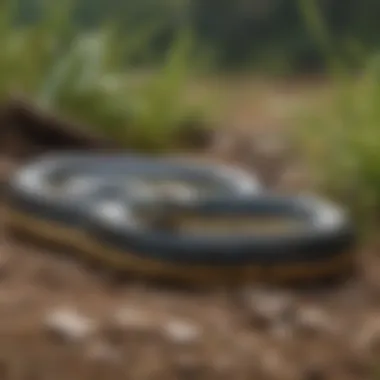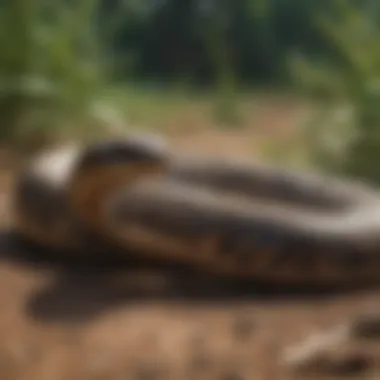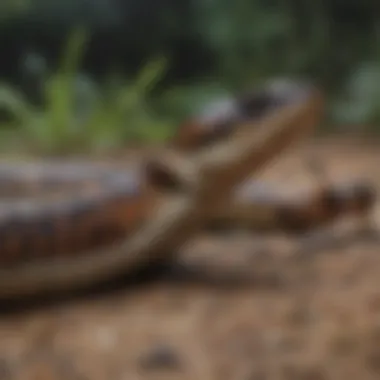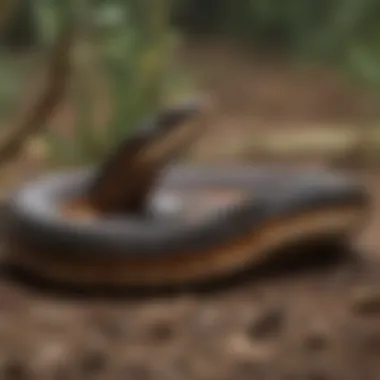Effective Strategies to Remove Garter Snakes Safely


Intro
Garter snakes often evoke mixed feelings among homeowners. While these reptiles contribute positively to the ecosystem by controlling pest populations, their presence in residential areas can create unease. Understanding how to effectively manage and eliminate garter snakes from your property is crucial for maintaining a safe and comfortable living environment. This article provides an analytical exploration of various strategies aimed at reducing snake encounters, focusing on preventative measures, identification techniques, and humane removal options.
Identification of Common Pests
Description of Common Pests
Garter snakes are typically slender and range in color from black to green, often featuring stripes along their bodies. They are non-venomous and can grow up to several feet long. This species is known for its adaptability to different environments, making them common in gardens and yards. Though harmless, their sudden appearance can be alarming.
Signs of Infestation
Identifying the presence of garter snakes around your property involves observing certain telltale signs. Common indicators include:
- Sightings: Often, finding one snake can signal more exist nearby.
- Shed Skin: Snakes periodically shed their skin; finding sheds around your home suggests habitation.
- Droppings: Similar to bird droppings, snake feces can be a clear sign of their presence.
"Understanding the signs of snake presence is the first step in effective management."
Prevention Techniques
Home Maintenance Tips
Effective garter snake management starts with diligent home maintenance. To deter these reptiles, consider the following practices:
- Seal Entry Points: Closely inspect your home for small openings where snakes can enter. Use caulk or sturdy materials to seal these areas.
- Declutter Yard: Remove piles of debris, wood, or rocks where snakes can hide.
- Manage Vegetation: Keep grass and shrubs trimmed and avoid dense undergrowth, which may provide cover for snakes.
Environmental Modifications
Creating an unwelcoming environment for garter snakes can also be achieved through environmental adjustments:
- Install Fencing: A snake-proof barrier is often effective. Ensure it is deep enough in the ground to prevent burrowing.
- Remove Water Sources: If possible, eliminate stagnant water. Garter snakes are drawn to moisture, so filling in puddles and maintaining proper drainage can help.
Eco-Friendly Pest Control Options
Natural Pesticides
For those looking for humane removal methods, several natural pesticides can be considered. Essential oils, such as peppermint and clove, have been recognized for their unpleasant scent to snakes. Spraying these oils around entry points can act as a deterrent. Vinegar is another option, as its strong smell can be off-putting.
Organic Pest Control Techniques
Engaging in organic pest control is beneficial for both the environment and snake populations. Techniques include:
- Natural Predators: Encourage birds of prey, such as hawks and owls, to inhabit your area, as they can help manage snake populations.
- Habitat Management: Adjusting the ecosystem to favor wildlife that preys on snakes can be an effective way to control their numbers naturally.
Understanding how to deal with garter snakes using non-invasive and humane methods can greatly enhance the comfort of your home environment. Each step taken towards removal and prevention contributes to a balanced ecosystem while ensuring your safety.
Understanding Garter Snakes
Understanding garter snakes is crucial for homeowners facing these reptiles on their properties. Garter snakes play significant roles in local ecosystems yet can pose challenges for those unfamiliar with their habits and behaviors. By grasping the basic facts about garter snakes, individuals can manage their presence without unnecessary harm to wildlife or personal safety.
Species Identification
Garter snakes belong to the genus Thamnophis. There are over 30 species, but the common garter snake, Thamnophis sirtalis, is the most prevalent in North America. Identifying them is vital in determining whether control is necessary. Garter snakes can typically be recognized by their long, slender bodies, ranging from 18 to 54 inches. They often exhibit three distinctive stripes along their length, with colors usually being green, brown, or black. Their patterning and colors can vary widely based on environment and species, making accurate identification essential.
Habitat Preferences
Garter snakes are adaptable creatures, thriving in a variety of habitats. They favor warm places such as grasslands, woodlands, and near water sources. Garden areas, as well as piles of leaves or debris, can serve as inviting shelters. Such locations provide the right conditions for basking under sunlight and hiding from potential predators. Understanding these habitat preferences helps when designing strategies to prevent snake intrusion on properties.


Diet and Behavior
Garter snakes primarily feed on small animals such as earthworms, frogs, and small fish. Their diet plays a crucial role in keeping pest populations in check, thus highlighting their ecological importance. Regarding behavior, garter snakes are generally shy and prefer to escape rather than confront larger animals. They are more active during the warmer months and may seek shelter during colder periods. Observing their behavior patterns can inform homeowners about when they are likely to be most active, allowing for better planning regarding property management.
Understanding the behavior and ecology of garter snakes can empower homeowners to make informed decisions on handling their presence, balancing safety with ecological mindfulness.
Reasons for Seeking Snake Removal
Understanding the various motivations for seeking the removal of garter snakes from residential properties is crucial. Homeowners may initially perceive these snakes as a benign aspect of their environment. However, several compelling reasons drive the decision for removal. Addressing this issue is not simply about personal comfort. It involves safety, potential property damage, and the broader impact on local ecosystems.
Safety Concerns
Garter snakes typically pose low risk to humans. However, many people fear snakes regardless of their harmless nature. This fear can stem from a lack of understanding about snakes and their behaviors. A fear of potential encounters often prompts homeowners to seek removal. Children playing outside may be particularly susceptible to anxiety if they spot a snake. It can lead to panic and also encourage misguided approaches to handling snakes, undermining safety.
In rare cases, a garter snake may exhibit defensive behavior when cornered. This action, while not aggressive, can be alarming. Ensuring that all individuals on the property understand how to cohabitate with such wildlife can reduce anxiety.
Property Damage Potential
Beyond personal safety, garter snakes can contribute to indirect property damage. These snakes, while primarily consuming small rodents and insects, can lead to increased populations of these pests in residential areas. Homeowners expect effective pest control, and the presence of snakes can indicate larger rodent issues. If left unchecked, this situation may escalate, leading to structural damage caused by rodents, and increasing the need for more aggressive pest control methods or repairs.
Additionally, garter snakes often take shelter in gardens or under porches, which can disrupt landscaping efforts. They may also unintentionally cause harm by disturbing gardens when hunting for prey.
Ecosystem Imbalance
The presence of garter snakes in urban areas can contribute to ecological imbalances. These snakes often hunt small mammals and insects, which in turn sustain the balance within the local ecosystem. If garter snake populations become too large or too small, it can lead to an overabundance or scarcity of prey species. This imbalance can ultimately change the dynamics of the local environment.
Furthermore, the removal of garter snakes may inadvertently alter the ecosystem. Understanding these dynamics is critical for any homeowner contemplating snake removal. Seeking professional advice or employing humane removal techniques can ensure that ecological balance is maintained, even while addressing individual concerns.
"It's important to remember that wildlife management should never compromise the health of the surrounding ecosystem."
Preventing Garter Snakes from Entering Your Property
Preventing garter snakes from accessing your property is essential for maintaining a safe and comfortable living environment. These snakes, while generally non-venomous and often beneficial, can still pose risks or become unwelcome visitors. Effective preventive measures not only reduce the likelihood of snake encounters but also foster a more secure space for your family and pets. By understanding the contributing factors that allow garter snakes to invade, homeowners can implement targeted strategies to keep them at bay.
Sealing Entry Points
One of the most effective methods to prevent garter snakes from entering your home is sealing potential entry points. Snakes are adept at squeezing through small gaps, thus it's critical to inspect your property carefully. Pay attention to the following locations:
- Gaps and Cracks: Look for openings around your foundation, doors, and windows. Sealing these with caulk or appropriate fillers can effectively block access.
- Utility Lines and Vents: Check where utility lines enter your home. Use mesh screens or foam insulation to cover these areas.
- Unsealed Basement Windows: If your basement has windows, ensure they are securely closed and locked. Consider installing window screens that are fine enough to prevent snakes but still allow ventilation.
By proactively addressing these vulnerabilities, you significantly decrease the likelihood of a snake making its way indoors.
Yard Maintenance Practices
Regular yard maintenance plays a vital role in deterring garter snakes. They are attracted to areas with abundant cover and food sources. Implement the following practices:
- Keep Lawns Well-Maintained: Regular mowing of the lawn reduces hiding spots for snakes, making your yard less attractive.
- Remove Debris: Clear away any piles of leaves, wood, or stone that can serve as shelters.
- Control Vegetation: Trim back bushes and shrubs that provide cover. Ensure that plants are spaced adequately to limit hiding spaces.
- Mulch Management: If using mulch, consider using materials that are less hospitable for snakes.
Making yard maintenance a routine activity not only enhances the aesthetic of your property but also minimizes habitats where snakes thrive.
Eliminating Food Sources
Another critical strategy in preventing snakes from invading is managing food sources. Garter snakes primarily feed on insects, small rodents, and amphibians. To eliminate potential food supplies, homeowners can take several steps:
- Rodent Control: Implement measures to keep rodent populations low. Use traps or consult pest control services if necessary.
- Insect Management: Regularly treat your garden and surrounding areas for insects to reduce food availability for snakes.
- Remove Standing Water: Snakes are attracted to areas with stagnant water, where they can find frogs or tadpoles to eat. Fill in any low spots that collect water and ensure good drainage.
By addressing food sources, you make your property less appealing to garter snakes and improve your overall outdoor environment.


Prevention is key. By being proactive, homeowners can significantly reduce the chances of encountering garter snakes.
Implementing these preventive measures creates a less inviting habitat for garter snakes, ensuring a more secure property for you and your loved ones.
Humane Removal Techniques
Humane removal techniques are essential when addressing the presence of garter snakes on your property. Unlike elimination methods that can harm or kill these creatures, humane approaches respect wildlife while effectively removing unwanted guests. By prioritizing humane practices, you ensure minimal stress for the snakes and help maintain the natural balance in the ecosystem.
Utilizing humane techniques can also foster a positive relationship with local wildlife. It is important to remember that garter snakes primarily feed on pests, which can benefit your garden and outdoor spaces. Thus, understanding their importance will influence how you approach their removal.
Capturing Methods
There are several effective capturing methods when it comes to humane snake removal. Physically capturing a snake can be intimidating, but it is a straightforward process. Here are some common methods:
- Snake Hooks: A snake hook allows you to gently lift the snake without causing harm. This tool is perfect for safely handling snakes without direct contact.
- Snake Traps: Live traps can be effective. These traps are designed to lure garter snakes in and prevent them from escaping. They should be checked frequently to ensure any captured snakes are handled quickly.
- Tongs: A pair of snake tongs can also help you grab and move snakes without risking bites or injury. Choose ones that have a firm grip and are designed for snake handling.
When using any capturing method, patience is key. Spooking a snake can make the situation worse. Approach slowly and firmly to avoid instant movements that may frighten the snake.
Relocation Considerations
Once you have safely captured a garter snake, relocation is the next step. Here are key points to consider:
- Distance: Relocate the snake at least a mile away from your property to ensure it does not find its way back.
- Habitat: Choose a suitable habitat that mirrors its natural environment. Look for areas with ample cover, such as logs, rocks, and tall grass. This will help ensure its survival.
- Timing: Relocate snakes during cooler parts of the day, like early morning or late evening, to prevent overheating and stress.
Do not release snakes in areas where they are not native or where their survival may be compromised. Always research the local regulations regarding snake relocation.
Tools and Equipment Needed
To effectively execute humane removal techniques, certain tools and equipment are essential. Below is a list of items that can aid in the process:
- Live Traps: These are typically made from metal or plastic and should be large enough to accommodate garter snakes.
- Snake Hooks or Tongs: As mentioned earlier, these tools will aid in safely handling snakes with minimal risk.
- Gloves: Wear thick gloves when handling any snakes, even if you are using tools, to prevent bites and maintain distance.
- Container: A secure container should be used during transportation to prevent escape during relocation.
It is vital to approach snake removal with respect and caution. Using the appropriate tools will ensure both your safety and that of the snakes.
Professional Pest Control Solutions
When facing a nuisance like garter snakes, many homeowners find themselves at a crossroads. Although the snakes play a role in ecosystem balance, their presence can be unsettling. This is where professional pest control solutions become significant. Engaging professional services can provide expertise that homeowners may not possess. These professionals understand snake behavior, which directly informs their removal strategies. Moreover, they are equipped with specialized tools and techniques to ensure that the removal is effective and humane.
Another key benefit is the safety factor. Attempting to handle snake removal personally can lead to possible bites or other accidents, especially for those inexperienced with reptiles. Professionals are trained to manage snakes and minimize risks involved. Consequently, this route often proves to be a sensible choice for those feeling uncertain.
When to Hire a Professional
Identifying when to seek help from professional pest control is crucial. If you notice several garter snakes frequently inhabiting your property, or if they are nesting, it’s a clear indication that assistance may be needed. Observing snakes in often-used areas poses a risk of unexpected encounters.
Additionally, if someone in your household has a phobia or an allergy that may exacerbate the situation, it is advisable to hire an expert. Professionals can deal with the situation more effectively and help put minds at ease. Overall, if the problem escalates beyond the realm of simple prevention techniques, enlisting a professional is wise.
Evaluating Pest Control Services
Choosing a pest control service requires due diligence. When evaluating potential companies, consider the following:
- Reputation: Look for reviews and testimonials. Platforms like Facebook and Reddit can provide insights regarding customer satisfaction.
- Experience: Consider how long the company has been in business and whether they specialize in humane reptile removal.
- Methods Used: Inquire about their approaches to snake removal. Ensure they prioritize humane methods, reflecting a commitment to animal welfare.
- Certifications: Check for relevant certifications that indicate their expertise in wildlife management.
It helps to gather multiple quotes to compare services and ensure you get a fair deal.
Costs Involved in Professional Removal
The costs associated with professional snake removal can vary based on several factors. Generally, prices can range from $100 to $500 or more. Factors that influence these costs include:


- Geographic Location: Prices can fluctuate based on region and local demand for pest control services.
- Severity of the Problem: More significant infestations may require more intensive services, leading to higher costs.
- Follow-up Services: Some companies offer continued monitoring or prevention services, which can add to initial costs.
While considering professionals for snake removal, always remember that the investment is often worth the peace of mind and safety provided.
"Professional pest control not only removes snakes but also offers lasting solutions to prevent future encounters."
Engaging a professional can streamline the daunting task of garter snake management, ensuring that homeowners can reclaim their peace of mind in their own yards.
Long-term Management Strategies
Long-term management of garter snakes on your property is essential for ensuring a safe and balanced ecosystem. It allows homeowners to establish effective practices that reduce snake encounters while also promoting a healthy wildlife community. The strategies outlined here help maintain a harmonious environment by preventing snakes from becoming pests. They can aid in minimizing the risk of unwanted snake appearances, thus enhancing the safety and comfort of your household.
Monitoring Your Property
Monitoring your property is critical for effective long-term management of garter snakes. Regularly checking the areas around your home can help identify early signs of snake presence. This might include looking for shed skins, feces, or track marks in the soil. Observing these signs early allows you to take preventative actions before a population establishes itself.
It can also be beneficial to keep track of seasonal patterns. Garter snakes tend to be more active during warm months. Keeping a log can help discern when they are more likely to appear, allowing for timely interventions.
Community Role in Wildlife Management
The community plays a vital role in managing wildlife, including garter snakes. Educating neighbors about these snakes can help foster a better understanding of their ecological importance. Organizing community workshops or discussions can highlight the benefits of garter snakes, such as their role in pest control. When everyone in a neighborhood understands the issue, collective action can be taken to manage the snake population responsibly.
Local regulations may exist that protect garter snakes, so engaging with community leaders can also impact wildlife management practices positively. Support from the community can lead to more structured approaches to managing snakes, such as habitat conservation or creating snake-friendly zones that keep these reptiles away from residential areas.
Educational Resources for Homeowners
Providing homeowners with access to educational resources regarding garter snakes is vital. Knowledge about their behavior, habitat, and benefits is necessary for fostering a safe coexistence. Resources such as local wildlife organizations or online platforms, including Wikipedia or Britannica, can offer valuable information. Homeowners can learn about preventative measures and humane removal techniques.
Additionally, sharing experiences through platforms like Reddit can enhance communal knowledge and strategies for handling these snakes. A well-informed homeowner is more likely to adopt practices that align with both personal safety and ecological preservation, benefiting the broader environment.
Legal Considerations
Understanding the legal framework surrounding the removal of garter snakes is essential for any homeowner facing this issue. Legal considerations not only clarify what actions are permissible but also outline the rights and responsibilities of property owners in relation to local wildlife. Ignoring these regulations can lead to legal repercussions, fines, or even penalties for harming protected species. Therefore, being informed about local laws ensures that the methods employed for snake removal are compliant and ethical, thereby promoting responsible wildlife management in residential areas.
Local Regulations on Snake Removal
Each locality may have its own set of rules when it comes to snake removal. Some states or municipalities may classify garter snakes as a non-threatened species, while others might have specific preservation laws. Homeowners should research local wildlife laws in their area.
- In some regions, it could be illegal to harm or relocate garter snakes without proper authorization.
- Permits may be required for trapping or relocating these creatures, depending on the state's wildlife regulations.
- Consulting local wildlife agencies can provide clarity on what is allowed and what legal steps need to be taken.
Failure to comply can complicate eradication efforts, as improper handling of snakes could lead to liabilities or unwanted legal issues.
Protection of Native Species
Garter snakes play a significant role in the local ecosystem. Many jurisdictions have enacted laws to protect certain native species, including garter snakes, which are essential predators for many small pests. This protection means that simply removing them without consideration can disturb the ecological balance.
- Protective laws exist to ensure that removal methods do not put these snakes at risk of extinction or harm.
- Engaging in illegal practices, such as poisoning or unregulated trapping, can lead to severe penalties.
- Homeowners should consider humane removal practices as a legal and ethical approach.
To effectively manage garter snakes on your property, it's critical to respect both the legal parameters and the ecological significance of these creatures. By doing so, homeowners not only protect themselves legally but also contribute positively to the preservation of local wildlife.
"Understanding your local regulations can save you from unnecessary legal troubles while ensuring that you manage wildlife responsibly."
End
The conclusion of this article serves as a crucial summation of the discussed strategies for effectively eliminating garter snakes from your property. Understanding the context and relevance of this topic is imperative for homeowners facing potential invasions of these reptiles. Garter snakes can cause unease, regardless of their generally harmless nature. Thus, clear methods for removal and prevention are essential for maintaining safety and comfort at home.
Key Takeaways
- Understanding garter snakes is essential. Recognizing their behavior and habitat preferences helps assist in prevention strategies.
- Preventive methods minimize encounters. Sealing off possible entry points and maintaining the yard reduces attraction.
- Humane removal techniques are both ethical and effective. Capturing and relocating snakes protects local wildlife while addressing homeowner concerns.
- Professional pest control may be necessary. In certain situations, skilled services provide knowledge and equipment that may surpass DIY efforts.
- Adhering to local regulations is vital. Understanding the legal protections regarding native species prevents future complications.
Final Thoughts on Snake Control
Controlling garter snake populations around your home requires a careful balance. Emphasizing prevention while maintaining humane removal practices is not only beneficial for homeowners but also essential for local ecosystems. Vigilance in monitoring your property and educating yourself and family on garter snakes can significantly reduce the likelihood of unwanted encounters.
Overall, the steps outlined in this article not only offer immediate relief but also cultivate a long-term approach to wildlife management. This ensures that homeowners can enjoy their properties without contending with the stress that garter snakes can bring, all while fostering a respectful relationship with the local wildlife.







